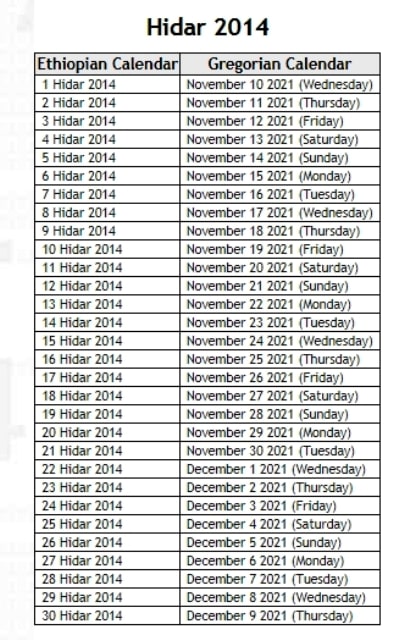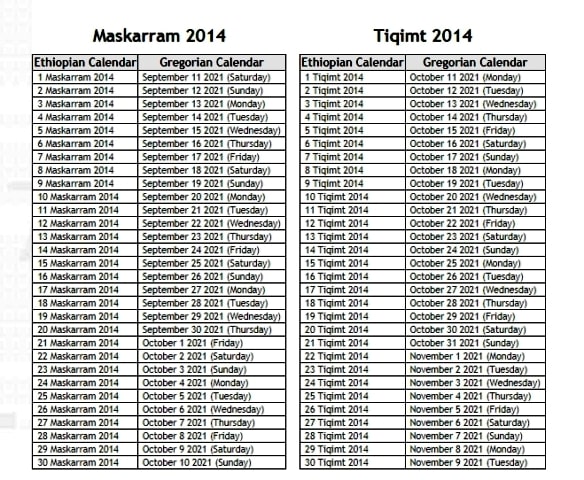The Ethiopian Calendar 2014: A Deep Dive into Historical past, Tradition, and Significance
Associated Articles: The Ethiopian Calendar 2014: A Deep Dive into Historical past, Tradition, and Significance
Introduction
With nice pleasure, we’ll discover the intriguing matter associated to The Ethiopian Calendar 2014: A Deep Dive into Historical past, Tradition, and Significance. Let’s weave attention-grabbing info and provide recent views to the readers.
Desk of Content material
The Ethiopian Calendar 2014: A Deep Dive into Historical past, Tradition, and Significance

The Ethiopian calendar, a novel and engaging system of timekeeping, holds a outstanding place within the cultural and non secular lifetime of Ethiopia and Eritrea. In contrast to the Gregorian calendar, which is predominantly used globally, the Ethiopian calendar follows its personal distinct rhythm, typically diverging considerably in dates from the internationally acknowledged system. This text explores the Ethiopian calendar 12 months 2014 (which corresponds to 2021-2022 within the Gregorian calendar), analyzing its historic context, its cultural significance, and the occasions that marked this specific 12 months.
Historic Roots and Distinctive Options:
The Ethiopian calendar, often known as the Ge’ez calendar, is a lunisolar calendar, which means it incorporates each lunar cycles and photo voltaic cycles. It is believed to have originated in historical Egypt, evolving over centuries and incorporating parts of each Egyptian and Byzantine traditions. An important distinction lies in its epoch, or start line. In contrast to the Gregorian calendar, which begins with the beginning of Christ (Anno Domini), the Ethiopian calendar’s epoch is historically reckoned from the Annunciation (the announcement of the beginning of Jesus to Mary), putting its 12 months 1 in roughly 7 BC within the Gregorian calendar. This discrepancy accounts for the seven-year distinction between the 2 calendars. Additional complicating issues, the Ethiopian calendar additionally has a special start line for its 12 months, starting on September eleventh within the Gregorian calendar.
The Ethiopian 12 months consists of 12 months, every with 30 days, adopted by an extra 5 – 6 days (often called Pagumen) to finish the 365-day 12 months. Leap years, occurring each 4 years with out the exceptions of the Gregorian calendar, add a sixth day to Pagumen. This technique, whereas seemingly easy, results in a gradual divergence from the Gregorian calendar over time.
Ethiopian Calendar 2014 (2021-2022 Gregorian): A 12 months of Transition and Challenges:
The Ethiopian 12 months 2014 (2021-2022 Gregorian) was a interval of great transition and problem for Ethiopia. The 12 months was marked by a fancy interaction of political, social, and financial elements, shaping the lives of its residents in profound methods.
Political Panorama:
The 12 months 2014 within the Ethiopian calendar witnessed the continuation of the political reforms initiated by Prime Minister Abiy Ahmed, who had taken workplace in 2018. Whereas Abiy’s reforms promised a extra open and democratic Ethiopia, the 12 months additionally noticed important challenges. The Tigray battle, which erupted in November 2020, solid a protracted shadow over the nation. The battle concerned intense preventing and humanitarian crises, resulting in widespread displacement and struggling. The 12 months 2014 noticed ongoing efforts to resolve the battle, albeit with restricted success. The political panorama remained unstable, with tensions between totally different ethnic teams and political factions persisting. The 12 months additionally noticed varied political arrests and trials, additional highlighting the fragile nature of the political transition.
Socio-Financial Situations:
The continuing battle in Tigray considerably impacted Ethiopia’s socio-economic situations. The disruption of agricultural actions and commerce routes led to meals shortages and financial hardship in lots of components of the nation. The humanitarian disaster required huge worldwide assist, highlighting the vulnerability of the nation’s financial system and infrastructure. Past the battle, the 12 months 2014 additionally confronted challenges associated to poverty, unemployment, and inequality, points which have lengthy plagued Ethiopia.
Cultural and Spiritual Significance:
Regardless of the political and financial turmoil, the Ethiopian calendar 12 months 2014 remained important for its cultural and non secular observances. The varied spiritual festivals and celebrations, together with Meskel (the discovering of the True Cross), Timkat (Epiphany), and Genna (Christmas), continued to be noticed with fervor, offering moments of unity and non secular reflection amid the prevailing challenges. These celebrations served as necessary reminders of the nation’s wealthy cultural heritage and non secular traditions. The 12 months additionally noticed the continuation of conventional practices and inventive expressions, reinforcing the resilience of Ethiopian tradition within the face of adversity.
Worldwide Relations:
Ethiopia’s relations with the worldwide neighborhood throughout the Ethiopian calendar 12 months 2014 have been advanced and infrequently strained because of the Tigray battle. The worldwide neighborhood performed an important function in offering humanitarian assist, however there have been additionally disagreements concerning the dealing with of the battle and the accountability of these concerned. The 12 months noticed diplomatic efforts to resolve the battle, with varied worldwide actors partaking in mediation and peace talks.
Wanting Forward:
The Ethiopian calendar 12 months 2014 concluded with Ethiopia going through appreciable challenges, but in addition with a way of hope for the long run. The 12 months marked a pivotal level within the nation’s historical past, revealing each the fragility and resilience of its political, social, and financial constructions. The continuing efforts to deal with the Tigray battle, promote nationwide reconciliation, and foster financial improvement would form the trajectory of the nation within the years to return. The distinctive options of the Ethiopian calendar, interwoven with the nation’s historical past and tradition, proceed to supply a framework for understanding the rhythm of life and the passage of time on this historical land. The 12 months 2014, subsequently, serves as a big marker within the ongoing narrative of Ethiopia’s journey in direction of a extra secure and affluent future. Additional analysis and evaluation are wanted to completely comprehend the long-term penalties of the occasions that transpired throughout this significant interval. The resilience of the Ethiopian folks, nonetheless, stays a strong pressure, shaping their future and their enduring connection to their distinctive calendar and its wealthy historical past.








Closure
Thus, we hope this text has offered helpful insights into The Ethiopian Calendar 2014: A Deep Dive into Historical past, Tradition, and Significance. We recognize your consideration to our article. See you in our subsequent article!